
Six-pack for Mars: A railroad to the Moon and Marsby Ajay Kothari
|
| Indeed, the most exciting and interesting prospect is that we can be on the Moon again in less than a year, Mars in three to four years, with humans to follow a few years after each if we use this method, because most of the modules needed are already available today. |
This method was described earlier here (see “A giant leap for America”, The Space Review, November 20, 2017). Principally it calls for launch of one of the low Earth orbit (LEO) reusable first stage rocket systems available today. The expendable upper stage would remain in LEO for a few days waiting another launch. The second upper stage docks with the first in orbit—do this multiple times if needed—to get to the Moon and use the tanks for habitats there. The question answered here is can we possibly get to a large enough propellant fraction to land on Moon or Mars? This particular work identifies a spectrum of possibilities, from Moon to Mars, from payload of 2,500 to 114,000 pounds on the lunar surface, using the same virtual railroad.
A few months ago Falcon Heavy flew successfully with two side cores coming back to land at Cape Canaveral. More recently, a Soyuz docked with ISS using a “fast-track” approach—within two orbits—without using human intervention. The method proposed earlier for Moon viz. refueling or mating the upper stages in orbit, which would be five to ten times cheaper than SLS, starts to build the virtual railroad. The delta-v needed for the Moon requires three to four flights, Mars would require five to six. Additional flights would very much fit the definition of this “railroad” or “roadway” as extensions thereof. Once we have perfected the Moon transport solution, technologies for slightly longer stays in orbit, additional mating, and the much longer transport time for Mars would be developed.
The delta-v’s given below, in meters per second, are for different sections. The concept here is that we place the expendable upper stage in LEO for a few days and then have the next flight’s upper stage rendezvous with the first one. They will dock or refuel. Every time this is done, the propellant fraction of the combination will increase. The question then to be answered is at what point does the propellant fraction obtained equal or great than the one dictated by the subway diagram below?
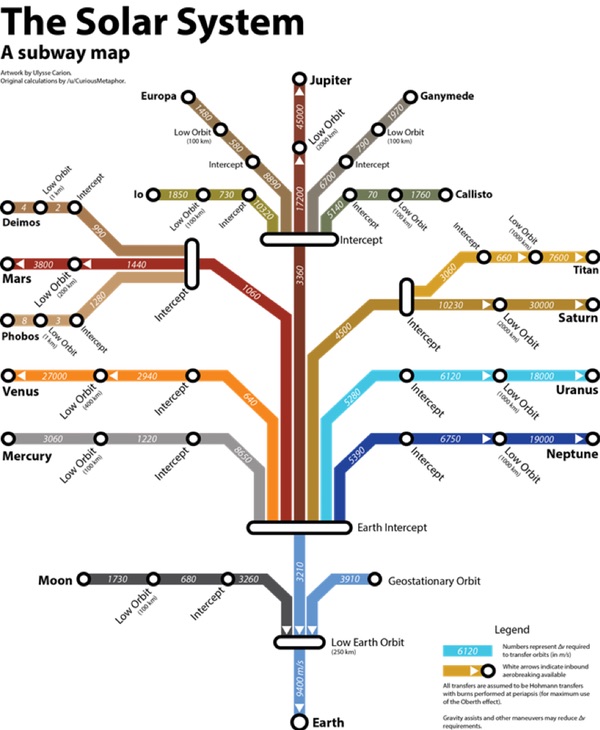 |
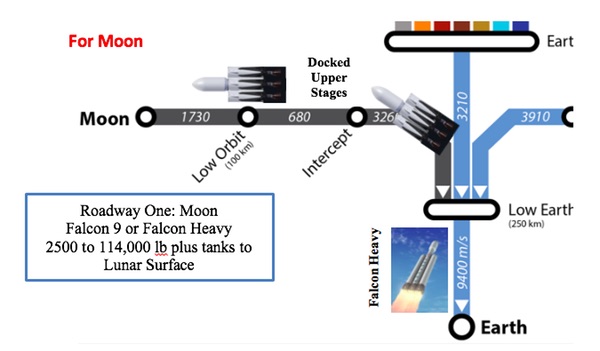 |
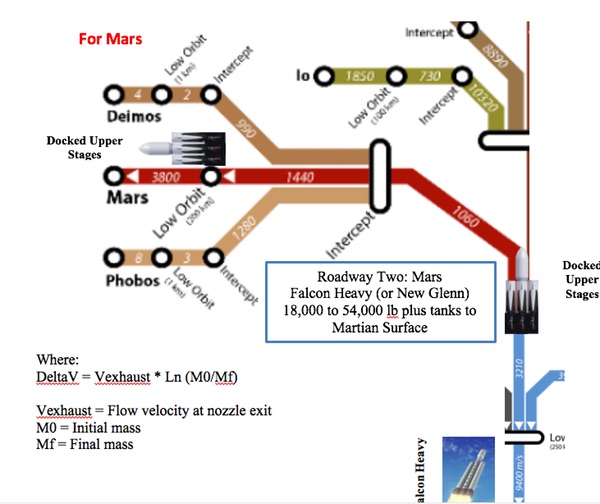 |
These delta-v values, though need to be converted into propellant fraction required. This was done using HySIDE code of Astrox. They are, of course, different for different engines used for the upper stage and/or the fuel used in them. The models for these engines are built in HySIDE and confirmed with the Isp (specific impulse, measured in seconds) ascertained.
 |
While RP-1 is the densest (805 kilograms per cubic meter) of the three fuels considered, its Isp with LOX (liquid oxygen) is lowest. While LH2 (liquid hydrogen) is the least dense (68 kilograms per cubic meter), its Isp is the highest. However, long term storage of LH2 for Mars flights or for trans-Earth injection from Moon or Mars back to Earth is problematic. Methane seems to be a good compromise at density of 423 kilograms per cubic meter and higher Isp than RP-1/LOX. Additionally, in situ synthesis of CH4 (methane) on Mars is possible, though at a later date. For all these reasons, methane is the fuel chosen for most of the analysis done here. Methane, which is a “soft cryo,” can be kept cold as needed by using a “tank inside tank” approach as BFR (Big Falcon Rocket) intends to do. It is not a showstopper.
The essential strategy as shown below, with the caveat that there would be enough flexibility exercised at any point to accommodate better ideas and exorcise the failed ones. Use of the Falcon vehicle from SpaceX is also used as an option. Blue Origin’s New Glenn and Phantom Express from Boeing/DARPA would also be worthy competitors:
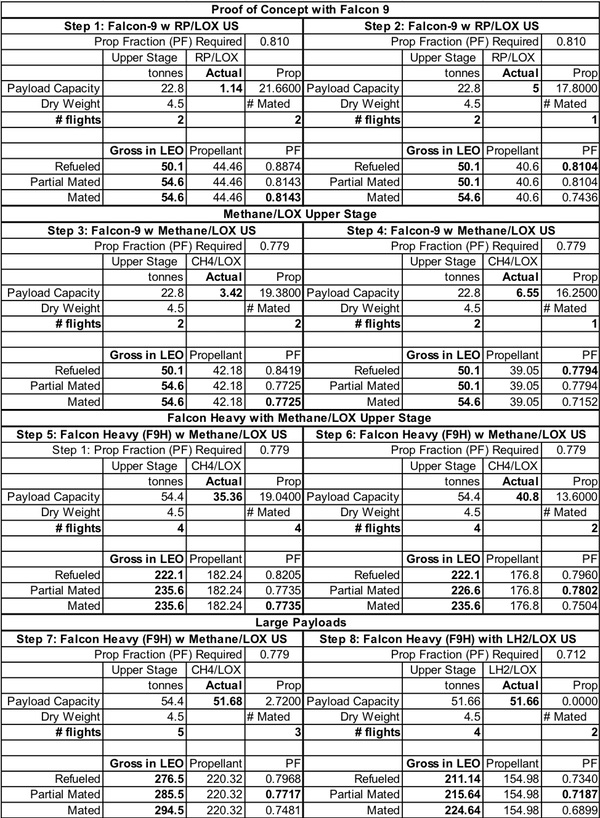 |
This would be done first. In fact, this can begin tomorrow: we can place payloads of 5,000 to 11,000 pounds on the Moon in less than one year. First, use Falcon 9 with its RP-1/LOX upper stage that has the potential to put 22.8 tons in LEO, but have payload of only 1.14 tons, which would allow additional 21.66 tons of propellant in the initial upper stage in orbit.
| This is about $3,500 per pound to the Moon. Granted, there will be other costs related to payload and incidentals, but even if we were to double it, it is considerably cheaper than SLS. |
One subsequent flight (one to five days later) will have no payload and hence 22.8 tons of extra propellant. Trans-lunar injection, intercept, and landing on Moon requires 18,606 ft/sec of delta-v, which translates to a propellant fraction for RP/LOX of ~0.81, as shown in the table above. Thus, we will be able to take 1.14 tons payload plus four tanks to Moon surface for proof of concept for mating in orbit, reigniting the engines and landing.
Later, if and when NASA has developed soft-cryo (LOX) refueling technology in orbit, we can also just refuel the initial upper stage and take only that to the Moon, in which case the payload increases to 5 tons. Thus, we will be able to take 5 tons payload plus two tanks to the lunar surface for this proof of concept fofor refueling in orbit, reigniting the engines and landing. However, this would not be attempted first.
Methane/LOX has a specific impulse 12 to 15 seconds higher than RP-1/LOX. So, if a methane engine (e.g. BE-4) becomes available, the upper stage can be powered by a smaller version of it instead.
First, use Falcon 9 with a methane/LOX upper stage that has the potential to put 22.8 tons in LEO, but have payload of only 3.42 tons, which would allow an additional 19.38 tons of propellant in the initial US in orbit. One subsequent flight (one to five days later) will have no payload and hence 22.8 tons of extra propellant. Trans-lunar injection, intercept, and landing on the Moon requires a propellant fraction for methane/LOX of ~0.779. Thus, we will be able to take 3.42 tons payload plus four tanks to the lunar surface for proof of concept for mating in orbit, reigniting the engines, and landing.
Later, if and when NASA has developed soft-cryo (methane and LOX) refueling technology in orbit, we can also just refuel the initial upper stage and take only that to the Moon, in which case the payload increases to 6.55 tons. Thus we will be able to take a 6.55-ton payload plus two tanks to Moon surface for this proof of concept of refueling in orbit, reigniting the engines, and landing. However, this would not be attempted soon.
With Falcon Heavy as a booster, we have a large variation in multiple permutations available with three degrees of freedom: payload size, number of flights, and the number mated in orbit. This allows us to reach different possible solutions depending on need and cost. Methane/LOX for the upper stage is used for all the options below as it is more efficient than RP-1/LOX and is also more storable than LH2/LOX. It should be reiterated here that the refueling options shown below are a function of NASA developing that in-orbit technology for soft-cryo fuels and later for hard-cryo fuel such as LH2.
Five flights of Falcon Heavy, with three upper stages being refueled and two discarded, allows us to take almost 51.68 tons to the lunar surface. Two of the three upper stages are landed on the surface with one continuing in low lunar orbit, which can be used for coming back to Earth. If and when LH2/LOX becomes available, we can also take almost the same payload to the lunar surface with four flights of the Falcon Heavy instead of the five needed for the methane option for the upper stage.
This option is available today without the need for BFR or SLS. Accounting for five flights of Falcon Heavy at the quoted rate of $93 million each, we can deliver 51.68 tons payload plus four tanks (habitats) on the lunar surface. This is about $3,500 per pound to the Moon. Granted, there will be other costs related to payload and incidentals, but even if we were to double it, it is considerably cheaper than SLS. And it can be started right away. Even going to Mars can be initiated in a few years using the same “railroad.”
The next question is: Can this solution, or its derivative, be extended to further expand the railroad to Mars, even if it may mean reduction in payload? The answer seems to be yes and appears very promising by being the cheapest option, creating that railroad to the Moon and Mars.
Extending the same “Railroad” idea, six flights of Falcon Heavy (hence the phrase “Six-pack for Mars”), with three upper stages being refueled and three discarded, allows us to take almost 16.32 tons to the Martian surface. Two of the three upper stages are landed on the surface with the other one continuing in low Mars orbit for use in coming back to Earth.
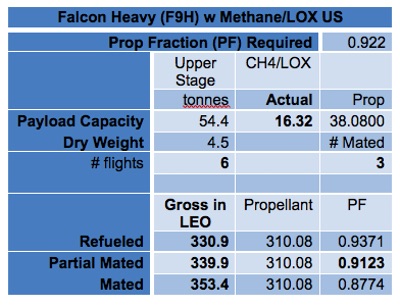 |
This can be the virtual “Railroad” that Bridenstine talked about this spring.
Using a methane upper stage supports a smaller payload but with a smaller number of flights. Four flights of Falcon Heavy, with two upper stages being refueled and two discarded, allows us to take almost 8.16 tons to the Martian surface. One of the two upper stages lands on the surface with the other remaining in low Martian orbit for a return to Earth.
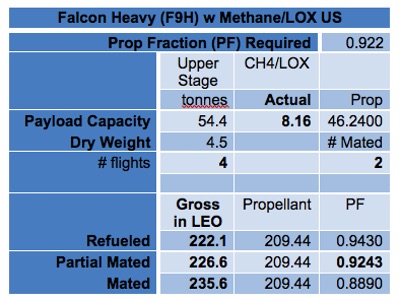 |
On the other hand, if cooling LH2 during the trip to Mars can be efficiently attained without much boil-off (possibly using solar electric refrigeration), then the payload is substantially increased to 54,000 pounds to Mars surface. Again, three upper stages are discarded after refueling the other three in orbit. These three are ignited for trans-Mars injection burn for intercept and landing on Mars. A deep-throttle engine will be needed for the intercept and landing or only one of the three will be lit. Again, one may remain in orbit for coming back to Earth.
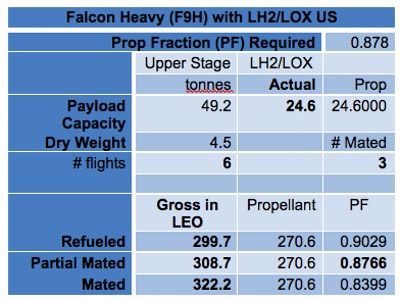 |
A “Railroad” to the Moon and Mars is indeed possible if we can cleverly take advantage of reusability of the first stage of vehicles, as proposed here. The initial tests for proof of concept can be done in one year with Falcon 9 as is. We can place about 2,500 pounds on the lunar surface. Later we could move to a methane upper stage as such rockets become available such as smaller versions of Raptor for the SpaceX BFR upper stage and Blue Origin’s BE-4. Falcon Heavy and New Glenn will avail us almost a continuous spectrum of permutations of payload, number of flights and number of US mated (even up to payload of 114,000 pounds to the Moon.) This is the Railroad.
| The same method, once enough confidence is attained in logistics, can be extended to many other destinations within the solar system for either robotic or human missions. |
There is really no exigent need for BFR or SLS for cargo, though they can be used for human transportation when available. Falcon 9, Falcon Heavy, New Glenn, and any other reusable first stage systems that may be developed can be used starting now for cargo transportation using this method, with several smoothly varying permutations at out finger tips, depending on the need at the time.
SLS Block 2 can place 95-130 tons in LEO at an estimated cost of $1.5-2.5 billion per flight. By contrast, using this method, the optimum solution shown above can place 285 tons in LEO at the cost of $600–800 million. This makes it about 7.23 times cheaper per pound to LEO, taking the average of the above numbers. This is also a gradual way that allows us more freedom, baby steps and still large payloads, even larger than SLS. The same method, once enough confidence is attained in logistics, can be extended to many other destinations within the solar system for either robotic or human missions.
This is somewhat of a revolutionary idea. The negatives are that it introduces additional maneuvers than if we went with SLS and BFR, but they are manageable as described above. The advantage is that vulnerability that comes with huge rockets such as SLS and BFR is reduced, and the development of them is not crucial to start our sojourns. A virtual trans-planetary railroad thus can be built by America for humankind.
Note: we are temporarily moderating all comments subcommitted to deal with a surge in spam.